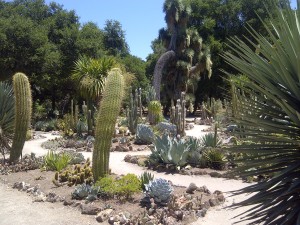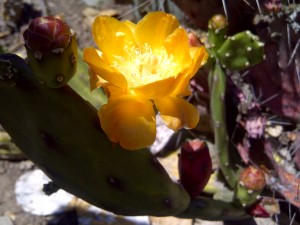I have always been fascinated by stories about how a long forgotten stunning geological formation or breathtaking canyon or intriguing system of caverns has been rediscovered, such as this one about a “lost” 400 foot waterfall. How extravagant we are forgetting beautiful things; someday they may be scarce.
We have one such treasure near my house, which is the Stanford family’s old cactus garden. The cacti are in bloom and I snapped these photos with my cell phone just now. The place reminds me of nothing so much as a mysterious forest from a Dr. Seuss book. 
It’s an amazing place, yet somehow its existence was forgotten for decades. In the 1880s, it was created to be adjacent to a grand family house that was never built. Maintenance of it stopped during World War II. It was gradually overgrown by other plants and then faded from collective memory. Fortunately it was rediscovered and is now being restored. It’s always open and free of charge, and very much worth a visit if you live in or are visiting the San Francisco Bay Area.

Where is it, actually? The links on that page are mostly dead.
Simplest way to find it is to go the psychiatry department on Quarry Road and park in the south part of its lot (which is free on weekends and after 4pm every weekdays), there is a paved path into the woods and you will see the cactus garden on your right in less than 5 minutes.
Here’s a Google maps link:
http://maps.google.com/maps?q=Stanford+University,+Menlo+Park,+CA&hl=en&ll=37.435876,-122.170715&spn=0.006006,0.011888&sll=37.0625,-95.677068&sspn=48.688845,97.382812&t=h&z=17
My wife runs the restoration project for Stanford; it made me happy to see this post on a favorite blog. I’ll see if I can dig up more links later. Other than her, most of the labor is volunteer - every third Saturday of each month there are volunteer work days.
Bruce: I am indebted to your wife and to the volunteers. They’ve done a marvelous job.